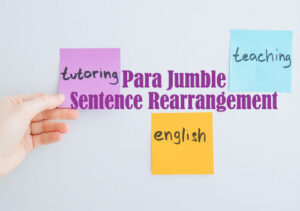Para Jumbles Questions and Answers with Problems Exercise
What is Para Jumbles in English?
Para Jumbles or Paragraph Jumbles are very common items for all competitive examinations. Sometimes it is called Sentence Rearrangement. Through this part of the examination, the examiner tries to understand the candidate’s verbal and reasoning skills. If you are going to appear for the Bank Recruitment Examination or MBA Entrance Test, you have to solve Para Jumble Questions.

In the Para Jumbles Section, you will get a paragraph where sentences are jumbled. Candidates have to rearrange the sentences so that they make logical sense.
What types of questions are asked in Para Jumbles?
Generally, two types of questions are asked in the Para Jumbled section. But they do not have any major difference. You have to apply same method and tricks to solve the problems.
- A set of sentences is given numbered A, B, C, D, E. These sentences are not in the right order. After these four options will be given to you. Each option will be a set of rearrangement. You have to choose the correct option which fits best as per the paragraph requirement.
- In this type a set of six sentences will be given in such a way that the first and last sentence will be fixed. Matching the first and last sentence, you need to rearrange the rest sentences to form a meaningful and logically correct paragraph.
How to solve Para Jumbles Questions?
Before any tips and tricks to solve Para Jumbles Question, be clear that only practice is the best option to make perfect.
- Detect the theme of the paragraph. First, read all the options. You will get an idea about the paragraph.
- Detect the opening sentence. The opening sentence will lead you to the other options to form a paragraph. If you try to get the closing sentence it will be easier to rearrange the paragraph. If you detect opening and closing statements together, it will be easy to rearrange the paragraph.
- Detect mandatory pairs. If two sentences are closely related to each other, then these two sentences must be mandatory pairs. Suppose, option C will come after option D, then DC is mandatory pairs. These mandatory pairs will help to eliminate the other options.
- Detect the transition words. Transition words of two different sentences will help to detect which sentence will come after or before another sentence.
- Check date and time. If any option mentions any date or time about any incident, you can get an idea which sentence will come after or before that sentence.
- Check personal pronounces. If any option contains a personal pronoun (he, she, it. etc) it refers that any noun is mentioned before this sentence.
We discuss some methods to solve the Para Jumble problems. We suggest you practice more for the best preparation.
Problems Exercise for Practice
Directions: Rearrange the following sentences in the proper sequence to form a meaningful paragraph; then answer the questions given below them.
1. A. Such gravitational lenses have been seen many times.
B. That means a heavy object such as a star, or even an entire galaxy, can act like a lens, bending light from things behind it to a focal point in front of it.
C. Indeed, they are used by astronomers as natural telescopes, since they sometimes provide glimpses of the most distant objects yet observed.
D. Gravitational lensing is a phenomenon that occurs because gravity, as Einstein showed, bends light.
E. However, if the missing matter, even though dark, was of a normal type, many more gravitational lenses would be expected, than have actually been observed.
1) DCBAE 2) DABEC T 3) DBACE 4) DECAB
2. A. In Greek times, and down to the time of Newton, planetary theory belonged to ‘philosophy’ because it was uncertain and speculative, but Newton took the subject out of the realm of the free play of hypothesis, and made it one requiring a different type of skill from that which it had required when it was still open to fundamental doubts.
B. It is often said that philosophy is unprogressive, but this is largely a verbal matter: as soon as a way is found of arriving at definite knowledge on some ancient question, the new knowledge is counted as belonging to science, and philosophy is deprived of the credit.
C. Until the eighteenth century science was included in what was commonly called “philosophy” but since that time the word ‘philosophy’ has been confined, on its theoretical side, to what is more speculative and general in topics with which science deals.
D. Let us consider first the relation to science.
E. Philosophy has been closely related to science on the one hand and to religion on the other.
1) CAEDB 2) CBEDA 3) DEBAC 4) EDCBA
3. A. But he did not know how to find one at that hour.
B. It was his first visit to the city and he didn’t know where to go.
C. Mohanlal’s train was late and it reached Kolkata a little after midnight.
D. He thought he would go to a choultry where he would not have to pay rent.
1) ADBC 2) BCDA 3) CBDA 4) CDBA
4. A. He raised his voice against idol-worship.
B. People are generally very open and accept social changes with a positive attitude.
C. Swami Dayanand Saraswati is remembered with reverence and affection among the social reformers of the nineteenth century.
D. India is a country which respects spiritualism much more than materialism.
1) BCDA 2) ACDB 3) CDAB 4) DBCA
5. A. Granted, political defection is increasingly less an act of ideological defiance than one of pure opportunism.
B. Yet, for all it flaws, the current law recognizes and respects one fundamental principle: The right to dissent.
C. A blanket ban on defection will weaken rather than strengthen democracy, in whose name it is being sought to he imposed.
D. Granted also that it is illogical to allow a third of the party to split but not in a lesser number.
1) CADB 2) ADCB 3) CDAB 4) ACDB
Previous Year Question Papers |


